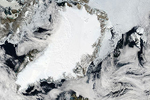Arctic sea ice could hit a record low by the end of the summer due to temperatures in the North Pole that are an astounding 11 to 14 degrees Fahrenheit (6 to 8 degrees Celsius) above average in the first half of July, reports the National Snow and Ice Data Center (NSIDC). Already the sea ice extent is tracking below this time in 2007, which remains the record year for the lowest sea ice extent. The sea ice hits its nadir in September before rebounding during the Arctic winter.
On July 17th sea ice extended 2.92 million square miles (7.56 million square kilometers), which is 865,000 square miles (2.24 million square kilometers) below the average sea ice from 1979 to 2000. Already the sea ice maximum this year (hit in March) was tied with 2006 for the lowest ever. The sea ice melt also began earlier than usual this year.
Experts predict that sea ice could vanish entirely from the Arctic during the summer within a few decades due to worsening climate change with massive impacts for the fragile Arctic ecosystems. A recent study found that the declining sea ice was forcing polar bears to make marathon swims and likely increasing mortality among cubs. While polar bears have become the symbol of the perils of declining sea ice in the fragile Arctic environment, a number of other species could suffer from less sea ice including narwhals, ringed seals, and walruses. Sea ice is also vital for the global climate. Reflecting sunlight, the sea ice keeps the Arctic cool and impacts global weather systems.
Average temperatures in the Arctic are rising around twice as fast as global temperatures, making the region especially sensitive to climate change.
Yet the melting Arctic has been seen by a number of Arctic governments not as a warning of climate change impacts, but as a chance to increase industrial exploitation of the region, including deep sea oil and gas drilling, and commercial fisheries.
Related articles
The truth about polar bears and climate change

(06/21/2011) Although scientists say innumerable species are threatened by climate change, polar bears have been the global symbol of the movement to rein-in greenhouse gas emissions. This is perhaps not surprising, since polar bears are well known to the public—even though they inhabit a region largely absent of humans—and they make a big impression. Their glaringly white coat contrasts with their deadly skills: as the world’s biggest terrestrial predators, they are capable of killing a seal with single blow. When young they are ridiculously adorable, but when adults they are stunning behemoths. But that’s not all. Unlike many other species, the perils of climate change are also easy to visualize in connection with polar bears: their habitat is literally melting away.
Greenpeace head arrested after nonviolent protest on Arctic oil rig

(06/19/2011) Kumi Naidoo, the head of Greenpeace, has been arrested after scaling a deepwater oil rig in the Arctic run by Cairn Energy. Naidoo was attempting to deliver a petition to the captain signed by 50,000 people demanding that Cairn Energy release details on how it would respond to an oil spill. “For me and for many people around the world this is now one of the defining environmental struggles of our time,” Naidoo said on a video before scaling the rig. “It’s a fight for sanity against the madness that sees the disappearance of the Arctic ice not as a warning, but as an opportunity to seek further profits.”
Russia and Norway carve up wildlife-rich Arctic sea for fossil fuels
(06/09/2011) As climate change melts the Arctic sea ice, nations are rushing to carve up once-inaccessible areas for oil and gas exploitation, industrial fishing, and shipping routes. Now, BBC reports that Russia and Norway have essentially agreed to split the Arctic’s Barents Sea in half —one of the region’s richest in biodiversity and ecological productivity—for industrial exploitation.